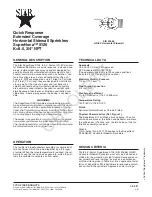
Section 9: Verifying the Model 9100 Accuracy Specification
9-3
Final Width = 215mm
9.5
Verification Points
The accuracy specifications detailed in Section 7 of this handbook cover the full range of
output values which can be generated by the 9100, and its accuracy can therefore be
verified against the specification at any number of points in these output ranges.
As the actual verification points chosen will depend to a large extent on the traceable
accuracy of the measuring equipment used to measure the 9100's outputs, it is beyond the
scope of this handbook to define a precise set of verification points for each of the 9100's
functions. However, when selecting verification points the following guidelines should
be followed:-
1) Where the 9100's specification is broken up into several different output amplitude
and/or frequency bands, verification points should be close to the top and bottom of
these spans.
For 9100 functions which can be directly calibrated (DC and AC Voltage, DC and AC
Current, Resistance and Capacitance) the default or recommended 'calibration targets'
detailed in Section 10: Calibrating the 9100 can be used as suitable verification points.
2) Capacitance bridges are not generally suited to verifying the 9100's capacitance
outputs for a number of reasons. Firstly, capacitance bridges are too inaccurate at the
extremes of frequency and impedance required to verify the full range of 9100
capacitance outputs (0.5nF to 40mF). Secondly, bridges often ground one of the
9100's output terminals, which prevents the calibrator from operating correctly (the
9100 is designed to drive fully floating loads.) A suitable transfer measurement
technique, using a set of standard capacitors and a floating capacitance meter, is
detailed in the capacitance calibration sub-section of Section 10: Calibrating the
Model 9100, in this handbook.
















































